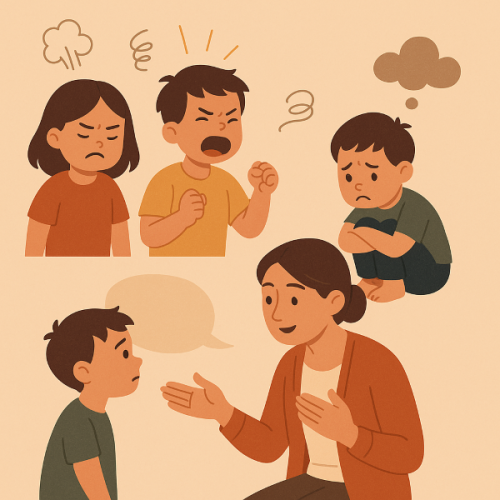Anger is a natural human emotion—even for children. While it is often misunderstood or mislabeled as “bad behavior,” anger serves an important purpose in a child’s emotional development. For many children, especially those still learning to regulate their emotions, anger and outbursts are common ways of expressing frustration, fear, unmet needs, or a sense of powerlessness.
When addressed with empathy, structure, and psychological insight, these moments become valuable opportunities for growth—for the child and for the parent or caregiver.
Why Children Get Angry
Children may experience anger for a variety of reasons, including:
- Frustration when they cannot express their needs or wants clearly.
- Fear or anxiety in response to change, separation, or overwhelming environments.
- Perceived injustice such as unequal treatment or feeling unheard.
- Fatigue, hunger, or overstimulation, which can lower tolerance and trigger meltdowns.
- Developmental stages, such as the “terrible twos” or adolescence, when children are testing boundaries and striving for autonomy.
What may seem like an overreaction to adults is often a child’s best attempt at coping with a strong inner experience.
The Psychology Behind Outbursts
From a psychological perspective, anger in children is not just about the emotion itself but about self-regulation, attachment, and emotional safety. When a child feels overwhelmed, their nervous system may shift into a state of “fight-or-flight”, leading to yelling, hitting, or screaming. Without the cognitive tools or language to process their emotions, these behaviors are expressions of inner distress—not deliberate defiance.
Repeated outbursts, especially when they are intense or prolonged, may signal underlying issues such as:
- Emotional regulation difficulties
- Anxiety or sensory processing challenges
- Trauma or insecurity in the caregiving relationship
- Neurodevelopmental conditions (e.g., ADHD, autism spectrum)
How to Respond Effectively
Empathic and structured guidance can help children feel safe, understood, and capable of change. Here are key strategies:
1. Stay Calm and Regulated
Children co-regulate with adults. If a parent or teacher remains calm, it helps the child settle. Harsh reactions may escalate the behavior and damage trust.
2. Name the Feeling
Use simple language to help the child identify their emotion: “It looks like you’re really mad because we had to leave the park.” Naming feelings helps build emotional literacy and reduces confusion.
3. Set Clear, Loving Boundaries
All emotions are acceptable, but not all behaviors are. Offer firm yet caring boundaries: “It’s okay to be angry, but not okay to hit. Let’s find another way.”
4. Offer Safe Outlets
Encourage physical expression in safe ways: punching a pillow, stomping feet, drawing their anger, or squeezing a stress ball can help release tension.
5. Talk It Through Later
Once calm, help the child reflect: “What happened earlier? How did you feel? What can we do differently next time?” This builds insight and problem-solving skills.
6. Model Healthy Anger Expression
Children learn most through observation. Show them how you handle frustration by expressing your own feelings responsibly and using coping strategies like deep breathing or taking a break.
When to Seek Professional Support
While occasional outbursts are normal, persistent or extreme anger may need evaluation. Consider seeking psychological support if:
- Anger leads to self-harm or aggression toward others.
- The child expresses intense guilt or shame after outbursts.
- Outbursts interfere with daily life, school, or relationships.
- You, as a parent or teacher, feel overwhelmed or unsure how to respond.
A psychologist can assess the child’s emotional development, explore possible underlying causes, and provide therapeutic tools for the child and the family system.
Children don’t need to be “fixed”—they need to be understood. Anger is not a problem to eliminate, but a signal to decode. With consistent guidance, emotional safety, and professional support when needed, children can learn to transform their anger into self-awareness, resilience, and emotional strength.

